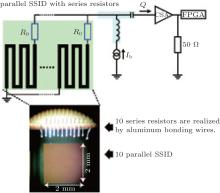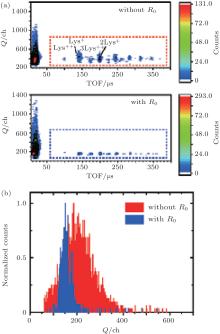†Corresponding author. E-mail: n.zen@aist.go.jp
*Project supported by a Grant-in-Aid for Scientific Research (A) and (C) from the Japan Society for the Promotion of Science (Grant Nos. 22246056 and 24619013).
In time-of-flight mass spectrometry (TOF MS), superconducting strip ion detectors (SSIDs) in the parallel configuration are promising for ideal ion detection with a nanosecond-scale time response and a practical large sensitive area. In the parallel configuration, the bias current in one strip is diverted into other parallel strips after each detection event. Under high bias current conditions, the diverted bias current induces cascade switching of all parallel strips. Studies show that cascade switching degrades the ion count rate of SSIDs made from niobium and hence is disliked in TOF MS applications. To suppress the bias current redistribution, we connected resistors in a series with the individual parallel strips using aluminum-bonding wires. Their effect was studied by measuring the pulse height distributions.
Superconducting strip ion detectors (SSIDs) consist of superconducting strip lines with a thickness of a few tens of nm and a width of less than 1 μ m. They have ultra-high sensitivity and narrow output pulse widths of a few ns that are ideal for time-of-flight mass spectrometry (TOF MS).[1] The conventional ion detector for TOF MS, the micro-channel plate (MCP), suffers sensitivity degradation from high-mass molecules because the detecting principle of the MCP is based on the secondary electron emission upon ion bombardment, with a quantum efficiency that is inversely proportional to the square-root of the ion mass.[2] In contrast, the detecting principle of the SSID is based on breaking the Cooper pair in a superconducting strip, the binding energy of which is several meV, which is 2– 3 orders of magnitude smaller than the work function of the MCP.[3] Therefore, in TOF MS, SSIDs inherently are capable of 100% detection efficiency for ions with kinetic energies of more than several tens of keV.
However, the conventional SSID which consists of a single meander-shaped strip line that lacks a practical large sensitive area. In TOF MS, an ion beam in general spatially spreads over an area with a diameter of ∼ 1 cm, and hence a detector size of the same order is necessary for high-throughput measurements. As the response time of the SSID is determined by the kinetic inductance of the superconducting strip line, [4] which is proportional to the length of the strip, it is difficult to accommodate a large detection area with a fast response time. To resolve this problem, we have been developing SSIDs with a parallel configuration.[5, 6] Because the inductance is inversely proportional to the square of the number of parallel strips, we were able to produce large SSIDs without degrading the response time. Currently, a detector size of 2 mm × 2 mm and a response time of several ns have been achieved.[7]
In the parallel configuration, the bias current that is necessary to drive the SSID is redistributed among other parallel superconducting strips and remains there after each ion detection event, [8, 9] because the superconducting strips have zero resistance. Because each strip is randomly irradiated by ions, the remaining bias current dynamically changes for every ion impact, which results in a broad distribution of pulse heights in the output signals. In contrast, under higher bias conditions, the redistributed current induces a cascade of normal transitions in other parallel superconducting strips that have not been triggered by ion impacts. According to our previous results, [8] this cascade switching degrades the ion count rate of Nb-SSIDs and its occurrence is unwanted in TOF MS applications. To suppress the bias current redistribution, which is the origin of the cascade switching, simulation studies have shown that resistors in series with each superconducting strip effectively work and result in an output pulse height distribution that is much improved. In this study, we fabricated SSIDs with series resistors using aluminum-bonding wires and measured the resulting pulse height distributions. Although such resistors have already been integrated in superconducting strip photon detectors (SSPDs) for the purpose of resolving photon numbers in an energy range of 1 eV, [10– 12] the effect of resolving ion number is not discussed as multiple-ion events are rare in our TOF MS experiments.
Following the schematic layout of the experimental setup (Fig. 1), biomolecule samples are ionized by matrix-assisted laser desorption/ionization (MALDI) using an N2 laser (λ = 337 nm) with a pulse width of 3 ns at 3 Hz. The MALDITOF MS instrument (Voyager DE-STR, Applied Biosystems, South San Francisco, CA) is operated in the linear mode. The biomolecule sample is lysozyme from chicken egg white (molecular weight 14300). The matrix is sinapic acid. Most of the ions generated by MALDI are singly charged. The ionized biomolecules are accelerated by a high voltage pulse of 25 kV and pass through the flight tube until they strike the SSID surface in the pulse-tube cryostat. For ions, a through-hole from room temperature to the cryogenic temperature of 3.2 K is required. To minimize heat radiation, a stainless steel collimator and a thermal radiation blocking filter are placed in front of the detector.[13]
The SSID consists of a 40-nm-thick Nb film sputtered onto a silicon substrate and patterned by i-line lithography (λ = 365 nm) and CF4 reactive ion etching. The strip width and space are both 1 μ m, and thus the filling factor is 50%. By connecting ten strips in parallel, a detector size of 2 mm × 2 mm is achieved. A bias current of Ib = 25 mA is applied to the SSID through a bias tee (model 5545, Picosecond Pulse Labs, Boulder, CO) with critical current of Ic = 50 mA. When Ib is close to Ic, thermal runaway occurs, for which the SSID remains in a normal-conducting state after an ion event.[14– 16] This limits the stable bias range to less than 25 mA. The output signal is measured by a 20 GS/s digital oscilloscope (WavePro 7000A, Teledyne LeCroy, Chestnut Ridge, NY) with a load resistance of Rload = 50 Ω . No preamplifiers are used for the measurement. The rise time for 10%– 90% of the pulse peak is less than 5 ns.
Each of the ten parallel SSIDs has a resistor R0 connected in series (Fig. 2); the ten resistors are formed using bonding wires made of Al. The bonding wires at both ends are for ground connections. Each bonding wire has a length of 1.5 mm and a resistance of approximately 7.5 mΩ at the operation temperature of 3.2 K.
To measure the pulse height distribution of SSIDs, the output from a bias tee is connected to a charge-sensitive amplifier (CSA) instead of an oscilloscope. The CSA output voltage pulse height is proportional to the charge Q accumulated by the CSA. Subsequently, the CSA output pulse is processed and recorded by the field programmable gate array (FPGA) at a resolution of eleven bits. In this way, both pulse height and TOF for each ion event are obtained at the same time. Details of the measurement setup are described elsewhere.[8] To evaluate the effect of R0, two parallel SSIDs with and without resistors are fabricated on the same chip and thereby cooled simultaneously. All experimental conditions including the biomolecular sample preparation, ionization, acceleration voltage, bias current (25 mA) to SSIDs, and FPGA setup are the same for both SSIDs.
Figure 3(a) shows two scatter plots of Q vs. TOF; the upper and lower panels correspond to the results without and with series resistors R0, respectively. Each dot corresponds to an ion detection event. For example, the event group at TOF of around 140 μ s represents the singly-charged monomer lysozyme (Lys+ ), and the group at around 170 μ s corresponds to the doubly-charged trimer lysozyme (3Lys+ + ). The signals below TOF of 40 μ s are assigned to the matrix (sinapic acid) molecules. Excluding the matrix events, the distribution of Q for events in the dashed-line box is depicted in Fig. 3(b). With the resistors (blue), the distribution of Q exhibits an improvement, which is attributable to the suppression of the bias current redistribution.
In contrast, the distribution of Q for the matrix events (dotted group below TOF of 40 μ s in Fig. 3(a)) broadens for the SSID with resistors (up to approximately 1300 ch) than that without resistors (up to 900 ch). This is due to the small R0 (7.5 mΩ ). The redirected bias current returns to the same strip in a certain time; the recovery time is expressible as

where L is the inductance of one superconducting strip. Using L = 1800 nH obtained from our previous study, [8]τ recover is calculated to be 240 μ s, which is longer than the duration time of 40 μ s for the matrix molecule impact events. Sequential matrix ion impacts that occur rapidly before the strip has time to recover its bias current produce a broader Q distribution. In contrast, because the count rate of lysozyme events (red and blue dashed-line boxes in Fig. 3(a)) is much smaller than that of matrix events, there is sufficient time between events for the strips with resistors to recover its bias current.
To improve the bias current redistribution, even for highcount- rate measurements, a faster τ recover is mandatory; that is, a smaller L or a larger R0 is necessary. With a short strip length, the detector size however is sacrificed. Additionally, a large strip cross-section with small L requires a large bias current to yield a suitable quantum efficiency, but nevertheless induces thermal runaway.[14– 16] Hence, a larger R0 is seen as the only solution. With an average number of impinging matrix per laser shot of 5.9 and a duration time for matrix events of 40 μ s, a recovery time of several μ s is sufficient to realize a high-count-rate measurement without the accompanying bias current redistribution. Therefore, a series resistor of approximately 1 Ω is necessary. However, assuming R0 = 1 Ω and a bias current of 25 mA, Joule heating in the Al bonding wire is of order 62.5 μ W, which may raise the chip temperature. Because the bias current of the SSIDs is enormously large, a simple connection of series resistors to superconducting strips needs to be avoided and electrical paths are necessary to provide a free-flowing DC bias current around the series resistors.
Resistors connected in a series to the parallel strips of an SSID suppress the distribution of the output pulse heights; and the dynamical change in the bias current that occurs after each ion event is partially suppressed. Looking ahead, fabrication of parallel SSIDs with series resistors of approximately 1 Ω , through which the DC bias current does not flow, would provide better ion detection performance and more practical SSIDs for use in applications.
| 1 |
|
| 2 |
|
| 3 |
|
| 4 |
|
| 5 |
|
| 6 |
|
| 7 |
|
| 8 |
|
| 9 |
|
| 10 |
|
| 11 |
|
| 12 |
|
| 13 |
|
| 14 |
|
| 15 |
|
| 16 |
|





